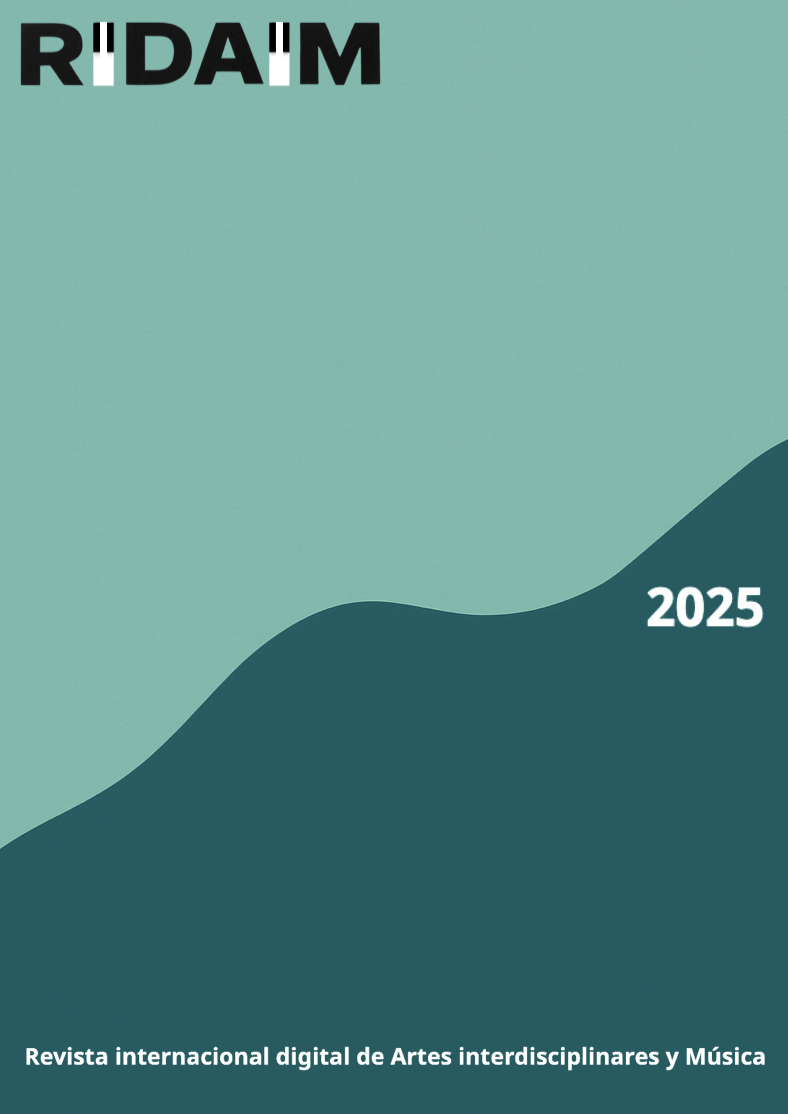Medieval Music in comics:
between historical accuracy and visual recreation
Keywords:
Medieval Music, Comics, Musical Iconography, Musical Instruments, Cultural HeritageAbstract
The representation of medieval music in contemporary visual media, such as comics, constitutes a significant resource for the transmission of cultural heritage. However, its analysis from a musicological and iconographic perspective has received little scholarly attention. The aim of this study is to examine the narrative and visual strategies used to depict medieval music in a selection of comics published between 1937 and 2020. The methodology combines an iconographic analysis of instruments, contexts, and graphic resources with a review of their narrative function, based on a corpus of six titles that include both historical fiction and educational works. The results reveal two predominant trends: a realistic approach based on documentary sources, and a symbolic, pedagogical approach that is more flexible in its historical interpretation. The recurrent presence of visual clichés (such as lute-playing troubadours or singing monks) is observed, alongside notable accuracy in the depiction of instruments such as the psaltery, vihuela, hurdy-gurdy, and portative organ. Musical notation and theory are scarcely represented, with music instead portrayed primarily as a social and cultural phenomenon. The study concludes that comics are an effective medium for recreating and disseminating medieval music, capable of combining historical accuracy with narrative creativity. Furthermore, it highlights their potential as a tool for teaching and promoting the history of music.
Downloads
References
Altarriba, A. (2008). La historieta, un medio mutante. Quimera: Revista de literatura, 293, 48-55.
Barthes, R. (1986). Lo obvio y lo obtuso: Imágenes, gestos, voces. En Fernández Medrano (Trad.). Paidós.
Bishop, C. (2016). Medievalist Comics and the American Century. University of Mississippi Press.
Caldwell, J. (2019) [1978]. Medieval Music. Taylor y Francis.
Eco, U. (1979). A theory of semiotics. Indiana University Press.
Eisner, W. (1985). Comics and sequential art. Poorhouse Press.
Elvira Barba, M. A. (2008). Arte y mito: manual de iconografía clásica. Silex.
Falguera-Garcia, E., y Selfa-Sastres, M. (2023). El cómic como lectura crítica de la historia en la construcción de la identidad y la diversidad territorial. Ocnos, 22(1). https://doi.org/10.18239/ocnos_2023.22.1.337
Galván, F. (2008). La imagen de la Edad Media en el cómic: entre la fantasía, el mito y la realidad. Revista de poética medieval, 21, 125-173.
Gallo, J. P. y Játiva, M. V. (2017). Cómic y Edad Media: del escenario a la didáctica. Monografías Aula Medieval, 6, 124-138.
Gallo, J. P. y Játiva, M. V. (2009). La presencia de la Edad Media en el cómic. En J. L. Martos Sánchez y M. García Sempere (Coords.) L'edat mitjana en el cinema i en la novel·la històrica (pp. 231-254). Institut Interuniversitari de Filologia Valenciana.
García, S. (2010). La novela gráfica. Astiberri.
Groensteen, T. (2006). Un objet culturel non identifié: La bande dessinée. Éditions de l´An 2.
Groensteen, T. (2007). The system of comics. University of Mississippi Press.
Gómez, A. (2011). El cómic como recurso didáctico en la educación superior. Revista de Educación y Cultura, 23(2), 45–62.
Gómez-Trigueros, I. y Ruiz-Bañuls, M. (2018). Interdisciplinariedad y TIC: nuevas metodologías docentes aplicadas a la enseñanza superior, Píxel-Bit. Revista de Medios y Educación, 52, 67-80. https://doi.org/10.12795/pixelbit.2018.i52.05
Hernando Morejón, J. (2023). From Iberia to Hispania: The Conquest of the Iberian Peninsula in the Spanish Graphic Narrative (1940–2020). HIOL: Hispanic Issues On Line, 31. https://hdl.handle.net/11299/256355
Herrero, H. (1998). El cómic de ambientación medieval al servicio del franquismo. Iber, 17, 109-122.
Hoppin, R. H. (2001). Medieval Music. W.W. Norton and Company.
Hurlbut, J. D. (2017). Comics Theory for the Ages: Text and Image Relations in Medieval Manuscripts. International Journal of Comic Art, 19(1), 353-383.
Kapp, K. (2012). The gamification of learning and instruction: Game-based methods and strategies for training and education. Pfeiffer.
Lee, P. W. (2013). Red Days, Black Knights: Medieval-themed Comic Books in American Containment Culture. En K. Fugelso (Ed.). Corporate Medievalism II. Studies in Medievalism XXII (pp. 181-200). D. S. Brewer.
López-Prados, S., y Saez-de-Adana, F. (2023). El Cómic como herramienta para la sensibilización sobre la necesidad de atender a la diversidad: Una mirada inclusiva. Ocnos, 22(1). https://doi.org/10.18239/ocnos_2023.22.1.333
McCloud, S. (1994). Understanding Comics: The Invisible Art. Harper Collins and Kitchen Sink Press.
de Mingo Lorente A. (2022). De fíbulas y viñetas: El mundo visigodo en el cómic. Arte, Individuo y Sociedad, 34(1), 389-408. https://doi.org/10.5209/aris.73597
Navarro Espinach, G. (2011). Cultura visual y enseñanza de la historia. La percepción de la Edad Media. Educación Artística Revista de Investigación, 2, 153-160.
Panofsky, E. (1955). Meaning in the Visual Arts. Papers in and on Art History. Doubleday Anchor Books.
Panofsky, E. (1972). Studies in iconology: Humanistic themes in the art of the Renaissance. Harper and Row.
Pratt, H. (2009). Narrative in comics. The Journal of Aesthetics and Art Criticism, 67(1), 107–117.
Rajewsky, I. O. (2005). Intermediality, Intertextuality, and Remediation: A Literary Perspective on Intermediality. Intermédialités Histoire et théorie des arts des lettres et des techniques, 6, 43-64. https://doi.org/10.7202/1005505ar
Reese G. (1940). Music in the Middle Ages. W.W. Norton and Company.
Rodrigo i Segura, F., Méndez Cabrera, J. y Fajkišová, D. (2023) (Coords.). Enseñar con el cómic: investigación y aplicaciones. Dykinson. https://doi.org/10.14679/2795
Rubio Muñoz, F. J. y Sanz Hermida, J. S. (2025). (Coords.). Aulas, historietas y TIC. el cómic como recurso transversal en la enseñanza universitaria. Un enfoque multidisciplinar desde la historia, lengua y matemáticas. Ediciones Universidad de Salamanca.
Sadie, S. et al. (Ed.). (1980). The New Grove Dictionary of Music and Musicians (6ª ed., Vol 15). Macmillan.
Sabin, R. (1996). Comics, comix and graphic novels: A history of comic art. Phaidon.
Tondro, J. (2011). Superheroes of the Round Table: Comics Connections to Medieval and Renaissance Literature. McFarland.
Varnum, R., y Gibbons, C. T. (2001). The language of comics: Word and Image. University Press of Mississippi.
Vich, S. (1993). La Edad Media en el cómic. Historia y vida, 305, 86-93.
Winternitz, E. (1967). Musical Instruments and Their Symbolism in Western Art. Studies in Musical Iconology, Yale University Press.
Wolinski, M. E. y Borders, J. (2020). Medieval Music, Oxford Bibliographies. Oxford University Press.
Downloads
Published
Issue
Section
License
Copyright (c) 2025 Nuria Torres

This work is licensed under a Creative Commons Attribution-NonCommercial-NoDerivatives 4.0 International License.
RIDAIM utiliza un sistema de licencia CC Reconocimiento-NoComercial-SinObrasDerivadas 4.0






